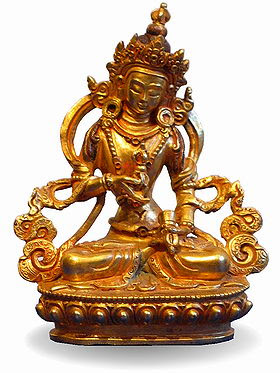พระโพธิสัตว์วัชรสัตโต

ธิเบตเรียก โด.เจ.เซม.ปา. จีนเรียก กิมกังสักตอ วัชรสัตโตท่านเป็นสัญลักษณ์แห่งโพธิจิตทั้งปวงแห่งจักรวาลเป็นโพธิจิตอันมั่นคงแข็งแกร่งประดุจวัชระ สรรพสัตว์เมื่อได้รับการอภิเษกจากท่านโพธิจิตก็บังเกิด ในมหายานนิกายเปิดองค์ท่านก็คือพระสมันตรภัทรโพธิสัตว์ ซึ่งถือว่าท่านเป็นบุตรคนโตของพุทธเจ้าทั้งปวงผู้ศึกษาปฏิบัติธรรม เมื่อตั้งปณิธานในการปฏิบัติ เริ่มด้วยการขอสรณะ ในการปฏิบัติที่ตามมาได้เกิดอุปสรรคต่างๆขึ้น ซึ่งเกิดจากกรรมทั้งเก่าและใหม่ กรรมทั้งมวลเกิดจากจิต เมื่อจิตไม่บริสุทธิ์โพธิจิตก็บังเกิดขึ้นไม่ได้ การขอขมากรรมเป็นหนทางย้อนสู่จุดเริ่มต้นเพื่อประกอบและไม่ประกอบกรรม อันเป็นต้นเหตุแห่งจิตบริสุทธิ์ ในพุทธศาสนาทุกนิกายมีวิธีการขอขมากรรมแตกต่างกันมากมาย ซึ่งการขอขมากรรมในบทปฏิบัติขององค์วัชรสัตโตนั้นถือว่าเป็นการขอขมากรรมขั้นสูงสุดเพื่อเข้าสู่พุทธภูมิ การปฏิบัติด้วยความศัทธา สำนึกผิดและปณิธานไม่ผิดอีก อกุศลกรรมความไม่บริสุทธิ์ทั้งมวลจะถูกกำจัดออกไปจนหมดสิ้นองค์วัชรสัตโตองค์ท่านใสบริสุทธิ์ดังเช่นหินผลึก ใสปรุโปร่งดุจดังสายรุ้ง มีหนึ่งเศียรสองแขน สวมอาภรณ์สัมโภคกายประดับจินดามณี มือขวาถือวัชระอยู่บริเวณหัวใจ ซึ่งวัชระนี้ก็คือปัญญาแห่งพุทธเจ้าห้าพระองค์ มือซ้ายถือกระดิ่ง ซึ่งก็คือปรัชญาปารามิตาหรือศูนยตาสภาวะ ท่านนั่งบนดอกบัวสีขาวในท่าวัชรอาสน์ ท่านเป็นสัญลักษณ์แห่งวัชรธรรมของพุทธเจ้าทั้งปวง วัชระในมือขวาของท่านขจัดอุปสรรคสิบประการ กระดิ่งในมือซ้ายดุจดังเสียงแห่งศูยนตาธรรมปลุกสรรสสัตว์ให้ตื่นจากสภาวะแห่งอวิชชาบทปฏิบัติขององค์วัชรสัตโตท่านสำคัญมากในการปฏิบัติพุทธตันตระยาน ด้วยว่าเป็นบทปฏิบัติหนึ่งที่ต้องปฏิบัติก่อนการปฏิบัติใดๆในทุกนิกาย(ดูได้ในเพจพื้นฐานวัชรยาน)
Vajrasattva [Buddha of Supreme Intelligence.]Vajrasattva by Tseden Namgyal

Mineral pigments and gold. painted on 2005. Size 43x33cm
The Svabhavika sect in Nepal identified Swabhava or Swa [own], bhava [nature] Adi-Buddha with Vajrasattva, who, according to the Nepalese Buddhist writings, manifested himself on Mount Sumeru in the following manner. A lotus-flower of precious jewels appeared on the summit of mountain which is the center of the universe, and above it arose a moon-crescent upon which,' supremely exalted', was seated Vajrasattva.
Vajrasattva is usually represented seated on a lotus posture. He wears a crown in which there is often an image of Akshobhya, and the dress and ornaments of Dhyani-Buddhisattva. Against his breast, he generally holds vajra in his right hand; but the vajra may be balanced on its point in the palm of his hand. With the left, he holds the ghanta on his hip. If standing, he balances the vajra in his right hand against his breast, while in the left, hanging pendent, he presses the ghanta against leg.
Vajrasattva Mantra

ธิเบตเรียก โด.เจ.เซม.ปา. จีนเรียก กิมกังสักตอ วัชรสัตโตท่านเป็นสัญลักษณ์แห่งโพธิจิตทั้งปวงแห่งจักรวาลเป็นโพธิจิตอันมั่นคงแข็งแกร่งประดุจวัชระ สรรพสัตว์เมื่อได้รับการอภิเษกจากท่านโพธิจิตก็บังเกิด ในมหายานนิกายเปิดองค์ท่านก็คือพระสมันตรภัทรโพธิสัตว์ ซึ่งถือว่าท่านเป็นบุตรคนโตของพุทธเจ้าทั้งปวงผู้ศึกษาปฏิบัติธรรม เมื่อตั้งปณิธานในการปฏิบัติ เริ่มด้วยการขอสรณะ ในการปฏิบัติที่ตามมาได้เกิดอุปสรรคต่างๆขึ้น ซึ่งเกิดจากกรรมทั้งเก่าและใหม่ กรรมทั้งมวลเกิดจากจิต เมื่อจิตไม่บริสุทธิ์โพธิจิตก็บังเกิดขึ้นไม่ได้ การขอขมากรรมเป็นหนทางย้อนสู่จุดเริ่มต้นเพื่อประกอบและไม่ประกอบกรรม อันเป็นต้นเหตุแห่งจิตบริสุทธิ์ ในพุทธศาสนาทุกนิกายมีวิธีการขอขมากรรมแตกต่างกันมากมาย ซึ่งการขอขมากรรมในบทปฏิบัติขององค์วัชรสัตโตนั้นถือว่าเป็นการขอขมากรรมขั้นสูงสุดเพื่อเข้าสู่พุทธภูมิ การปฏิบัติด้วยความศัทธา สำนึกผิดและปณิธานไม่ผิดอีก อกุศลกรรมความไม่บริสุทธิ์ทั้งมวลจะถูกกำจัดออกไปจนหมดสิ้นองค์วัชรสัตโตองค์ท่านใสบริสุทธิ์ดังเช่นหินผลึก ใสปรุโปร่งดุจดังสายรุ้ง มีหนึ่งเศียรสองแขน สวมอาภรณ์สัมโภคกายประดับจินดามณี มือขวาถือวัชระอยู่บริเวณหัวใจ ซึ่งวัชระนี้ก็คือปัญญาแห่งพุทธเจ้าห้าพระองค์ มือซ้ายถือกระดิ่ง ซึ่งก็คือปรัชญาปารามิตาหรือศูนยตาสภาวะ ท่านนั่งบนดอกบัวสีขาวในท่าวัชรอาสน์ ท่านเป็นสัญลักษณ์แห่งวัชรธรรมของพุทธเจ้าทั้งปวง วัชระในมือขวาของท่านขจัดอุปสรรคสิบประการ กระดิ่งในมือซ้ายดุจดังเสียงแห่งศูยนตาธรรมปลุกสรรสสัตว์ให้ตื่นจากสภาวะแห่งอวิชชาบทปฏิบัติขององค์วัชรสัตโตท่านสำคัญมากในการปฏิบัติพุทธตันตระยาน ด้วยว่าเป็นบทปฏิบัติหนึ่งที่ต้องปฏิบัติก่อนการปฏิบัติใดๆในทุกนิกาย(ดูได้ในเพจพื้นฐานวัชรยาน)
Vajrasattva [Buddha of Supreme Intelligence.]

Mineral pigments and gold. painted on 2005. Size 43x33cm
Color: white , Symbol: Vajra [thunderbolt],
ghanta [bell], Sakti [consort]: Ghantapani
Vajrasattva, the dhyani-boddhisattva or spiritual son of dhyani-buddha, Akshobhya is also regarded as chief of the five dhyani-buddhas.
The Svabhavika sect in Nepal identified Swabhava or Swa [own], bhava [nature] Adi-Buddha with Vajrasattva, who, according to the Nepalese Buddhist writings, manifested himself on Mount Sumeru in the following manner. A lotus-flower of precious jewels appeared on the summit of mountain which is the center of the universe, and above it arose a moon-crescent upon which,' supremely exalted', was seated Vajrasattva.
As sixth Dhyani-Buddha, Vajrasattva presides over the Yidam the protectors and has the same relation to the Adi-Buddha that the Manushi [human] Buddha has to his ethereal counterpart or Dhyani-Buddha. The sixth sense is believed to have emanated from him, as well as the last of the six elements of which man is composed-the manas, or mind.
SOME VAJRASATWA STATUES IN OUR DHARMA SHOP
Vajrasattva is usually represented seated on a lotus posture. He wears a crown in which there is often an image of Akshobhya, and the dress and ornaments of Dhyani-Buddhisattva. Against his breast, he generally holds vajra in his right hand; but the vajra may be balanced on its point in the palm of his hand. With the left, he holds the ghanta on his hip. If standing, he balances the vajra in his right hand against his breast, while in the left, hanging pendent, he presses the ghanta against leg.
Unlike the other Dhyani-Boddhas, he is always crowned with or without his sakti whom he presses against his breast in the yab-yum attitude, with the right hand holding vajra, while the left holds the ghanta on his hip. He holds the kapala [skull-cup] and vajra. This form is only worshipped in secret.
Mantra of Bajra satwa Click Play
Vajrasattva Mantra
Comments
Post a Comment